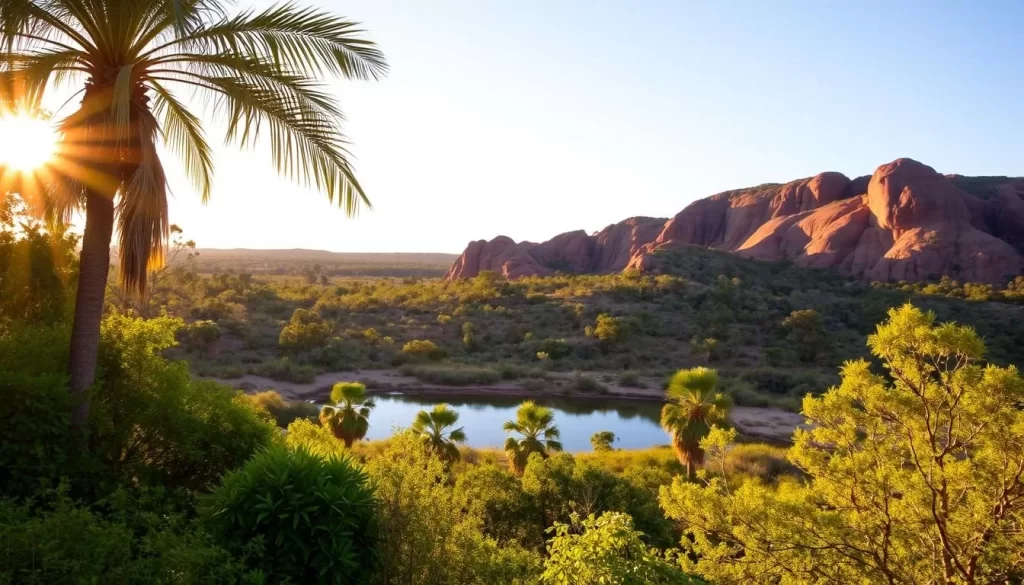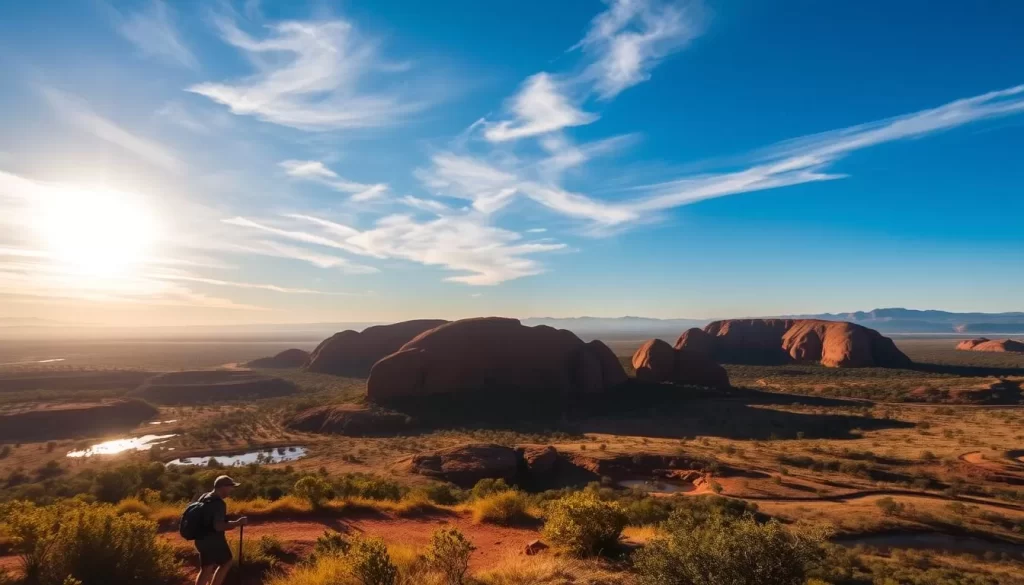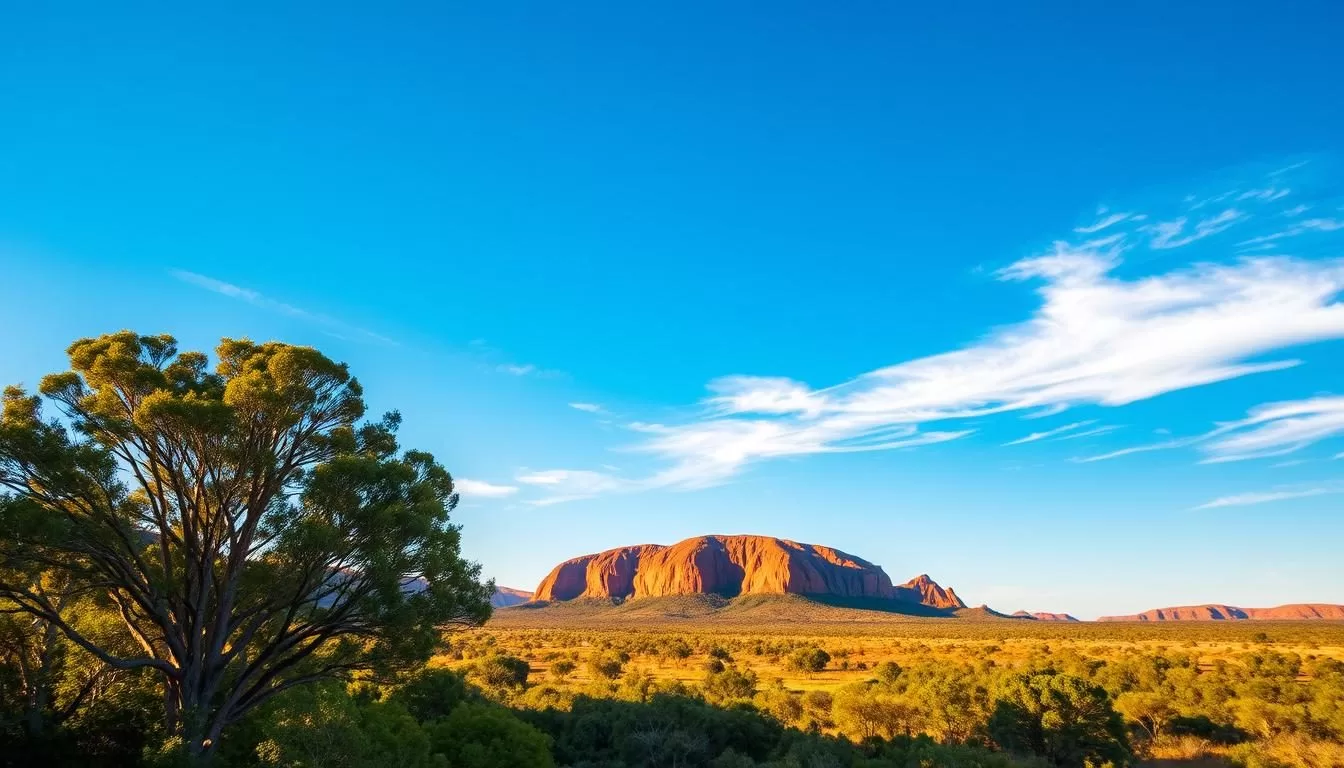✓ Accommodations ✓ Flights ✓ Rental Cars
Planning a trip to the Northern Territory? Understanding the local weather patterns can make your adventure unforgettable. This region offers a unique blend of tropical and semi-arid climates, making timing your visit essential for the best experience.
From stunning waterfalls to vibrant local festivals, the Northern Territory is a world of contrasts. Whether you’re exploring the lush Top End or the rugged Red Centre, knowing the best time to visit ensures you’ll enjoy every moment.
This guide will help you align your travel dates with local conditions. Discover tips on weather, events, and expert advice to make the most of your trip. Get ready to experience the magic of this incredible region!
Understanding the Northern Territory Climate
The climate in this region is as diverse as its landscapes. From the lush tropics to the arid deserts, the weather patterns here are shaped by two distinct zones: the Tropical Top End and the Semi-Arid Red Centre. Understanding these differences will help you plan your trip better.

Tropical Top End vs. Semi-Arid Red Centre
The Tropical Top End experiences a wet season from November to April and a dry season from May to October. During the wet season, you’ll encounter monsoonal rains and cyclones, with high humidity and dramatic weather. The dry season, on the other hand, offers cooler, pleasant days with lower humidity, making it ideal for outdoor activities.
In contrast, the Red Centre has a semi-arid climate with four distinct seasons. Summers are hot, with temperatures often exceeding 86°F (30°C), while winter nights can drop below freezing. This stark contrast makes the Red Centre a unique destination for those seeking desert adventures.
Exploring Seasonal Variations and Weather Patterns
Seasonal changes play a significant role in shaping your experience. In the Top End, the wet season transforms the landscape into a lush, green paradise, but heavy rains can limit access to certain areas. The dry season, however, is perfect for exploring national parks and waterfalls.
In the Red Centre, winter is the most popular time to visit due to its crisp, cool days. Spring and autumn offer milder temperatures, while summer can be challenging with extreme heat. Knowing these patterns ensures you’re prepared for the conditions you’ll encounter.
| Climate Zone | Season | Temperature Range | Key Features |
|---|---|---|---|
| Tropical Top End | Wet (Nov-Apr) | High humidity, 86°F+ (30°C+) | Monsoonal rains, lush landscapes |
| Tropical Top End | Dry (May-Oct) | Cooler, 77°F-91°F (25°C-33°C) | Pleasant weather, ideal for outdoor activities |
| Semi-Arid Red Centre | Summer (Dec-Feb) | 86°F+ (30°C+) | Extreme heat, limited outdoor activity |
| Semi-Arid Red Centre | Winter (Jun-Aug) | Freezing nights, cool days | Popular travel season, comfortable conditions |
Choosing the right season for your visit can enhance your adventure and ensure safety. Whether you’re exploring the tropics or the desert, understanding the climate will help you make the most of your trip.
Northern Territory, Australia: Best Months for a Weather-Savvy Trip
Timing your trip can make all the difference in your experience. The time you choose to visit influences everything from outdoor activities to overall comfort. Whether you’re hiking under the sun or stargazing on a cool night, understanding the nuances of the climate ensures a memorable adventure.

Why Timing Matters for Your Adventure
The temperature fluctuates significantly between day and night, especially in the Red Centre. During summer, daytime heat can exceed 113°F (45°C), making outdoor activities challenging. Winter, however, brings cooler days and frosty nights, ideal for exploring without the discomfort of extreme heat.
Here’s why the best time visit is crucial for your trip:
- Spring and autumn offer milder temperatures, perfect for hiking and sightseeing.
- Winter mornings are crisp and pleasant, while nights are ideal for stargazing.
- Summer provides access to natural waterholes, but planning excursions early in the day is essential to avoid the heat.
Savvy timing ensures you can enjoy activities safely and comfortably. For example, visiting during the dry season (May to October) means lower humidity and cooler weather. This period is perfect for exploring national parks and waterfalls without the risk of heavy rains.
By aligning your trip with the right time, you’ll maximize your experience and create lasting memories. Whether it’s hiking at sunrise or enjoying a cool night under the stars, timing is everything.
Trip Planning: Weather, Activities, and Insider Tips
Planning your journey with the weather in mind can elevate your experience. Whether you’re exploring national parks or attending local festivals, aligning your trip with the right season ensures a smoother adventure. Here’s how to make the most of your time visit.

Optimizing Conditions for Outdoor Exploration
Outdoor activities are best enjoyed during the dry season, from May to October. This period offers cooler temperatures and lower humidity, making it ideal for hiking, camping, and sightseeing. Avoid the extreme heat of summer by planning excursions early in the day or opting for shaded trails.
Here are some tips to optimize your outdoor adventures:
- Check local weather forecasts regularly to plan your activities.
- Pack lightweight, breathable clothing for daytime and warmer layers for cooler nights.
- Stay hydrated and carry sunscreen to protect against the sun’s intensity.
Seasonal Events and Local Festivals
Timing your visit with local events can add a unique cultural dimension to your trip. The Darwin Festival in August is a highlight, featuring live music, art, and food. Another must-see is the Barunga Festival, celebrating Indigenous culture with traditional performances and workshops.
For a relaxed evening, head to the Mindil Beach Sunset Markets. These markets offer a mix of local crafts, delicious food, and stunning sunset views. Visiting during the dry season ensures you’ll enjoy these events without weather disruptions.
Planning your trip around these festivals not only enriches your experience but also connects you with the local community. For more travel tips, check out this comprehensive guide.
Destination Weather Insights: Darwin, Alice Springs, and Uluru
Exploring the weather patterns of key destinations can transform your travel experience. From tropical humidity to desert extremes, each area offers unique conditions that shape your adventure. Here’s what you need to know about Darwin, Alice Springs, and Uluru.

Darwin and the Top End: Dry vs. Wet Season Experiences
Darwin’s climate is defined by two distinct seasons: the dry and the wet. From May to October, the dry season brings pleasant weather with average daytime temperatures of 86°F (30°C) and minimal rainfall. This is the ideal time for outdoor activities like exploring Kakadu National Park or enjoying the Mindil Beach Markets.
In contrast, the wet season (November to April) features monsoonal rains and high humidity. While the landscape becomes lush and vibrant, heavy rains can limit access to certain areas. Plan accordingly if you’re visiting during this period.
Alice Springs & Uluru: Navigating Desert Extremes
Alice Springs and Uluru are located in the heart of the outback, where the climate is starkly different. From March to May and September to November, Alice Springs offers milder temperatures, with daytime highs around 86°F (30°C) and cooler nights. This is the perfect time for hiking and exploring the MacDonnell Ranges.
Uluru, on the other hand, is best visited from April to October. During these months, daytime temperatures hover around 86°F (30°C), while nights can drop to 72°F (22°C). The clear skies and moderate weather make it ideal for sunrise and sunset viewings.
| Destination | Best Time to Visit | Daytime Temperature | Nighttime Temperature |
|---|---|---|---|
| Darwin | May to October | 86°F (30°C) | 77°F (25°C) |
| Alice Springs | March to May, September to November | 86°F (30°C) | 68°F (20°C) |
| Uluru | April to October | 86°F (30°C) | 72°F (22°C) |
Understanding these local insights ensures you’re prepared for the conditions you’ll encounter. Whether you’re exploring the lush wetlands of Darwin or the arid outback around Alice Springs, timing your visit can enhance safety, comfort, and overall enjoyment. For more tips on planning your trip, check out this .
Conclusion
Understanding the diverse climate of this region is key to planning a successful trip. From the lush tropics to the arid deserts, each area offers unique conditions that shape your experience. Choosing the right season ensures you’ll enjoy outdoor activities, cultural events, and stunning landscapes without weather disruptions.
Whether you’re exploring during the dry season or embracing the wet season, preparation is essential. Pack appropriately for temperature fluctuations, stay hydrated, and check local forecasts before heading out. These steps will help you navigate the region’s extremes safely and comfortably.
For more insights on planning your adventure, check out this guide to Australia’s seasons. With smart planning, you can make the most of your visit and create unforgettable memories. Start organizing your trip today and experience the magic of this incredible region!
The above is subject to change.
Check back often to TRAVEL.COM for the latest travel tips and deals.




